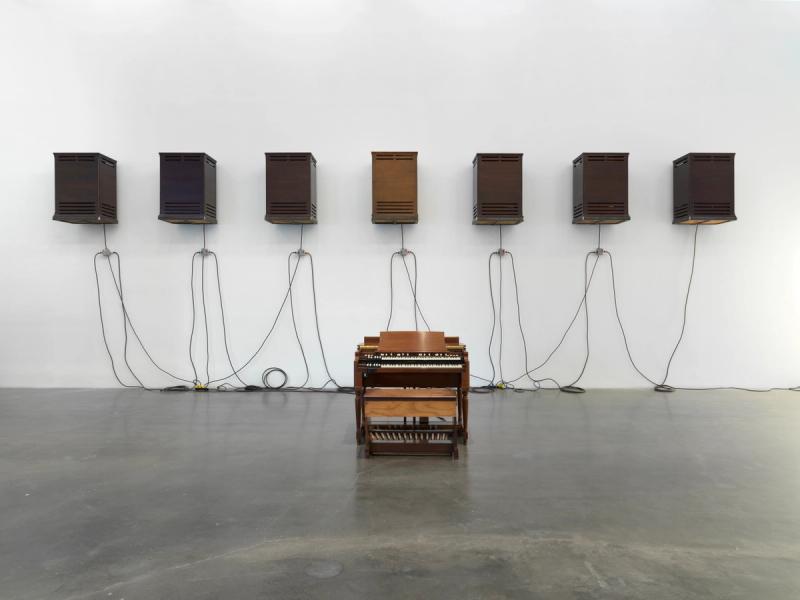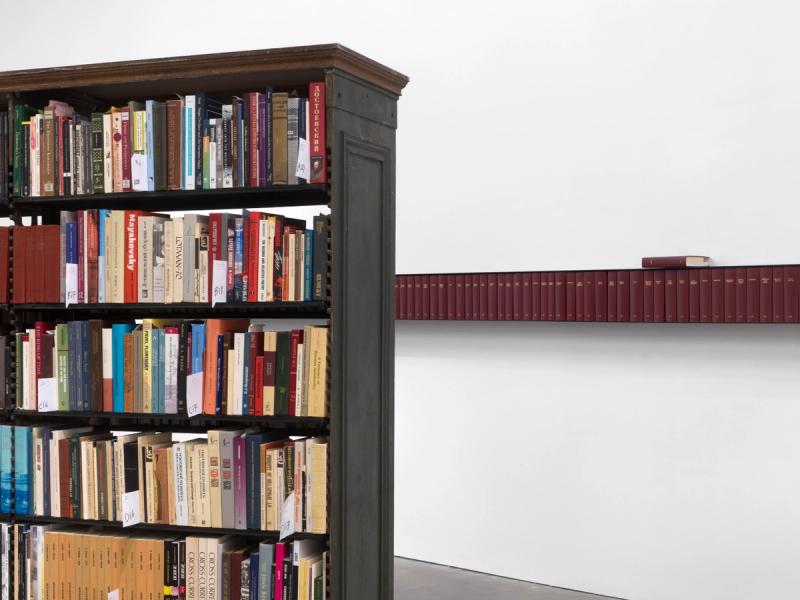
Theaster Gates’s New Exhibition Poetically Prods the Meaning of a Museum
What’s the purpose of a museum—and who decides which objects are worthy of value, attention, and care? These two questions, along with decades of inventive and collective artmaking, are at the core of “Young Lords and Their Traces” at the New Museum, the Chicago-based artist Theaster Gates’s first-ever museum survey exhibition to be staged in New York City (on view through February 5, 2023).
Also an urbanist and social activist who flows between making, preserving, and collecting, Gates operates a multifarious, cross-disciplinary practice, moving from archiving and caring for historical collections of images and objects to physical object-making, whether it be ceramics, painting, installation, or sculpture. Some of his works even verge on architecture. In developing the exhibition, New Museum curators Massimiliano Gioni and Gary Carrion-Murayari wanted to explore the intersectionality of Gates’s vast body of work, elevating his singular vision while also considering how, more generally, we think about and use objects in our everyday lives. “We were excited to look at Theaster as an artist and an object maker,” says Gioni. “There are many occasions in the exhibition when we look at his work as a cultural preservationist and a kind of cultural interpreter.”
From his studio in West Side Chicago, Gates has become globally revered and well-known for safeguarding and repurposing buildings in the city’s historically Black neighborhoods—many of which have been left to the elements, their histories decayed and forgotten. Perhaps his most transformational project is the Stony Island Arts Bank, which Gates overhauled from a crumbling, abandoned structure into a robust cultural center that houses community events and archival collections that speak to the history of the city itself.
“Young Lords and Their Traces” stems from a recent period of loss in Gates’s life, following the passing of several important figures, including the curator Okwui Enwezor, who originally conceived of the New Museum exhibition “Grief and Grievance: Art and Mourning in America”; the author and social activist bell hooks; the fashion designer Virgil Abloh; and Gates’s father, Theaster Gates Sr., who worked as a roofer. “In the introduction to [the exhibition catalog], Theaster talks about these losses intersecting with the show, and in a sense leading to the exhibition a somber atmosphere and a reflection on mourning,” says Gioni when asked about the roots of the exhibition. In reflecting on the process of mourning and grief, Gates began to think about the connection between objects and people, and how collections are used as a way to remember people and to honor their legacy. Memory can exist within artifacts and everyday objects that take on new meanings once a person connected to them is no longer alive. In this way, objects, collections, and even the buildings that Gates preserves function as sites of memorialization.
The thematic structure of the exhibition, which covers the museum’s second, third, and fourth floors, weaves in and out, connected by pieces made by Gates as well as his extensive archival collections—but it remains grounded in material. The second floor, displaying ceramic works, puts forward the idea of what is deemed worthy of remembrance, and how museums play a role in that decision-making. For Gates, clay is both a tool of preservation and also a material that records the process of self-discovery. “He’s interested in the way in which ceramics, both within African American culture and Japanese culture, represent a way of knowledge that is embodied in the physical presence and physical materials,” Gioni says. The second floor also puts on view the archive of the late Robert Bird, a University of Chicago professor of Soviet cinema and friend of Gates’s who died of cancer in 2020.
The third floor can be viewed as an ode to roofing paper: Gates’s tar paper paintings on display, originally conceived for his Serpentine Pavilion in London, are emblematic of his practice of reusing and highlighting discarded materials. It’s important to note Gates’s personal connection with tar, as his father used the material as a roofer. These paintings, too, serve as yet another form of remembrance. Along with displaying further collections of ephemera, this section of the exhibition further explores the idea of museums as sites of knowledge, remembrance, and even, at times, erasure.
On the fourth floor, there’s a space for communion, dedicated to how churches—especially Black churches—function both as spaces for sacred experience and community outreach. Containing artworks made from the floor of the former New York Armory, the space will be activated throughout the exhibition by live music and other performances.
Moving from the tangible—paper, clay, wood—to the ephemeral sense of loss and remembrance that can be assigned to or embedded within these materials, “Young Lords and Their Traces” journeys through deeply personal terrain, showcasing Gates’s exceptionally varied practice and reflecting on what a museum stands for. As viewers move through the galleries, the underlying hierarchies and values behind Gates’s impressive body of work come into focus. Reflections on who decides what and who should be remembered emerge.


